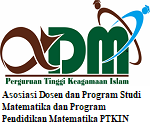Determining of Risk Factors of Low-Birthweight Babies in Padang, West Sumatra Using Logistic Regression Analysis
DOI:
https://doi.org/10.15642/mantik.2020.6.2.135-141Keywords:
Low birth weight babies; Risk factors; Logistic regressionAbstract
Infant mortality is one of the indicators used to measure the quality of life of a nation. The World Health Organization (WHO) stated that one of the main causes of infant mortality is the low birth weight (LBW). Efforts to reduce the incidence of LBW can be done by monitoring risk factors that influence the occurrence of LBW in the prenatal phase. This study aims to identify factors that significantly influence the incidence of LBW babies in Padang, West Sumatra, Indonesia. The analysis was carried out by using Logistic Regression Analysis on the data of maternal births domiciled in Padang, West Sumatra, Indonesia. It was concluded that variables that significantly affect the incidence of LBW are maternal weight, parity, distance from a previous birth, problems during pregnancy, and babies’ gender.
Downloads
References
The National Development Planning agency, "Laporan Pencapaian Millenium Development Goals Indonesia 2017
World Health Nation, "Global Nutrition Targets 2025: Low Birth Weight Policy Brief," World Health Nation, Geneva, July 2014.
I. P. Sari, Y. Ardillah, and T. A. Widyastuti, "The Determinat of Infant Mortality in Neonatal Period," Jurnal Kesehatan Masyarakat, vol. 12, no. 1, pp. 139-149, July 2016.
The National Family Planning Board, "Survei Kesehatan dan Demografi Indonesia [In Bahasa]," The National Family Planning Board, Jakarta, 2018.
S. Djaja and S. Soemantri, "The Cause of Neonatal Death and The Attributed Health Care System in Indonesia Mortality Study of Household Health Survey," Bul. Penel. Kesehatan, vol. 31, no. 2, pp. 153-156., 2003.
Direktorat Kesehatan RI Bina Kesehatan Masyarakat, "Manajemen Bayi Berat Lahir Rendah (BBLR) untuk Bidan Desa [In Bahasa]," Indonesia Ministry of Health, Jakarta, 2008.
F. Yanuar, H. Yozza, F. Firdawati, I. Rahmi, and A. Zetra, "Applying Bootstrap Quantile Regression for the Construction of a Low Birth Weight Model," Makara Journal of Health Research, vol. 23, no. 2, pp. 90-95, 2019.
S. Badshah, L. Mason, K. McKelvie, L. Payne, and P. J. Lisboa, "Risk Factors for Low Birth Weight in the Public Hospitals at Peshawar NWFP-Pakistan," Biomed Central, vol. 8, pp. 197-205, 2008.
S. Leila, D. Robab, and H. Somaiasadat, "Relationship between Maternal Haemoglobin Concentration and Neonatal Birth Weight," Biomed, pp. 373-376, 2013.
Tonasih and D. Kumalasary, "Faktor-faktor yang Mempengaruhi Berat Bayi Lahir Rendah (BBLR) di Puskesmas Wilayah Kesehatan Harjamukti Kota Cirebon tahun 2018 [In Bahasa]," Jurnal Riset Kebidanan Indonesia, vol. 2, no. 1, pp. 21-27, 2018.
H. S. Joshi et al., "Risk Factors for Low Birth Weight (LBW) Babies and It's Medico-Legal Significance," J.Indian Acad. Forensic. Med., vol. 32, no. 2, pp. 212-215, 2016.
L. D. Hailu and D. L. Kebede, "Determinant of Low Birth Weight among Deliveries at a Referral Hospital in Northern Ethiopia," Biomed Research International, vol. 2018, pp. 1-8, April 2018.
World Health Organization, "International Statistical Classification of Disease and Related Health Problems, tenth revision, 2nd edition," World Health Organization, Geneva, 2004.
A. Agresti, An Introduction to Categorical Data Analysis, 2nd ed. New Jersey, USA: John Wiley and Son, 2007.
D. G. Kleinbaum and M. Klein, Logistic Regression: A Self-Learning Text, 3rd ed. New York, USA: Springer-Verlag, 2010.
Downloads
Published
How to Cite
Issue
Section
License
- Authors retain copyright and grant the journal right of first publication with the work simultaneously licensed under a Creative Commons License that allows others to share the work with an acknowledgment of the work's authorship and initial publication in this journal.
- Authors are able to enter into separate, additional contractual arrangements for the non-exclusive distribution of the journal's published version of the work (e.g., post it to an institutional repository or publish it in a book), with an acknowledgment of its initial publication in this journal.
- Authors are permitted and encouraged to post their work online (e.g., in institutional repositories or on their website) prior to and during the submission process, as it can lead to productive exchanges, as well as earlier and greater citation of published work







.png)




